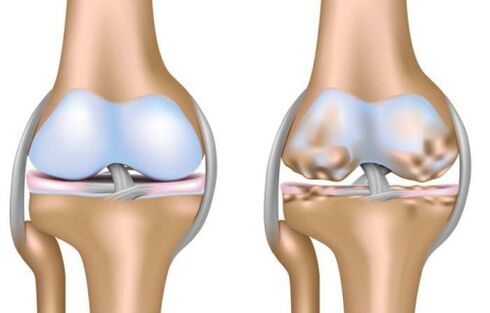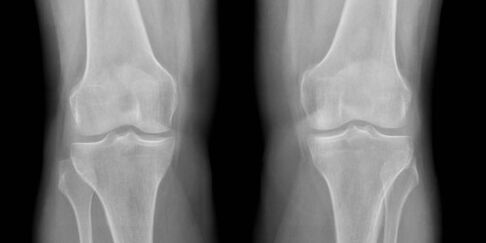Osteoarthritis of the knee joint (knee joint) is a disease that causes deformity of the cartilage of the knee joint. This disease is very common, especially among the older generation. The work of the knee deteriorates and therefore the difficulties in its mobility and the feeling of pain are the most important signs of the disease. Today, arthritis of the knee joint is also common in people 25-30 years old. What speaks of the flexibility of the causes of the disease and therefore its treatment. >There are two types of knee joint: unilateral (affecting only one knee) and bilateral (affecting both knees). Most often the disease occurs in its bilateral manifestation.

The reasons
Knee arthritis, like coxarthrosis, is more common in old age. Although there is no exception today and the fact that young people have symptoms of this disease. This suggests that the causes of arthritis are different and each in its own way can affect the onset, exacerbation and treatment of the disease. There is also the possibility of an organism being genetically predisposed, eg knee joint arthropathy may be more common in some families than in others. In addition, this disease may not be genetically determined. Therefore, there are several causes of knee joint.
- Various bodily injuries of the knee (bruise, dislocation, etc. ).
- Large loads that do not correspond to age (5-7% of all cases of knee joint, as well as cox joint).
- Excess body weight of the patient (10% of all cases of knee joint).
- Concomitant diseases, for example, arthritis (5-7% of all cases of knee joint, multi-joint and co-joint).
- Congenital weakness of the ligaments (3-5% of cases of knee joint).
- Metabolic syndrome and metabolic problems in the body.
- Spasm of the muscles of the upper thigh (up to 50% of cases of knee and knee joint).

Symptoms
The symptoms of osteoarthritis of the knee joint are mostly the same and occur in almost all patients. Patients also note that the exacerbation of pain falls in the spring-autumn period and depends on weather changes. The main symptom of the disease is knee pain. Most of the time, it does not appear immediately, but is noticed only after a long walk and appears late in the afternoon. Ringing may cause knee stiffness during movement. If the secondary symptoms are left unattended, then the disease can be caused and can bring extremely undesirable effects to the patient. Despite the main symptoms, there are many other signs of the disease:
- resting pain syndrome, which decreases qualitatively when walking.
- restriction of movement of the knee joint and difficulty in controlling its mobility.
- knee stiffness;
- increased sensitivity in the knee area.
- swelling in the knee joint and swelling of the skin around.
- deformity of the knee joint.
The condition of the knee joint is assessed during a doctor's examination and x-ray. In addition, the stage of the disease of any arthropathy (including coxarthrosis, knee arthrosis, polyarthritis, etc. ) can only be determined if there is an X-ray and only a doctor can evaluate such a condition. Therefore, it is extremely important that you do not engage in self-diagnosis and do not rush to conclusions.
Degrees of knee joint
1st degree
The knee joints did not succumb to the deforming effect of the disease, but appear only from external signs and a slight swelling of the periarticular skin, noticeable changes in its color. At a normal level, it is characterized by small changes in the vitreous cartilage. As a result of the accumulation of a significant amount of synovial fluid in the synovial nerve, small deformities of the joint occur, which are accompanied by pain when walking. Other signs such as limited mobility are not observed. And so it is also difficult to detect them on X-rays. At this stage, the disease is difficult to diagnose, but with a quick definition, its treatment will be more effective than with another or third degree of knee joint, as well as other types of joints (coxarthrosis, multiple joints).
II degree
The main symptom is unbearable or intense pain, even with a light load, which is aggravated by walking and lifting weights. Over time, this will develop into difficulty in bending the knee. At a normal level, this is manifested by the fact that the volume of the cartilage layer decreases sharply and in some places is completely absent. According to the results of the X-rays, this degree can be determined by the marginal bone growths and the density of the joint space. In the work of the joint, especially with a long walk, a characteristic sting appears. Gradually, the patient may lose the ability to bend the knee or it will be given with great difficulty. The phenomenon of deformation is already manifested at this stage of development of the knee joint, as well as other types of joints (coxarthrosis, multi-joint). Visually, this is perceived and the surrounding skin becomes rough and changes color. Treatment at this stage is best started complex and intensive. Here, both medicines and traditional treatments will be relevant.

III degree
It is characterized by severe pain, even when the knee joint is inactive or immobilized. The phenomenon of deformation is very noticeable and one can see visually significant changes in the structure of the joint and adjacent tissues. At a normal level, it is characterized by the absence of cartilage tissue and this is easy to diagnose by radiography. The treatment of grade III arthritis of the knee joint and other types of joints (multi-joint, co-joint) is in fact an irreversible process. Rather, the main goal of such treatment will be to reduce pain and eliminate some of the symptoms of the disease.




























